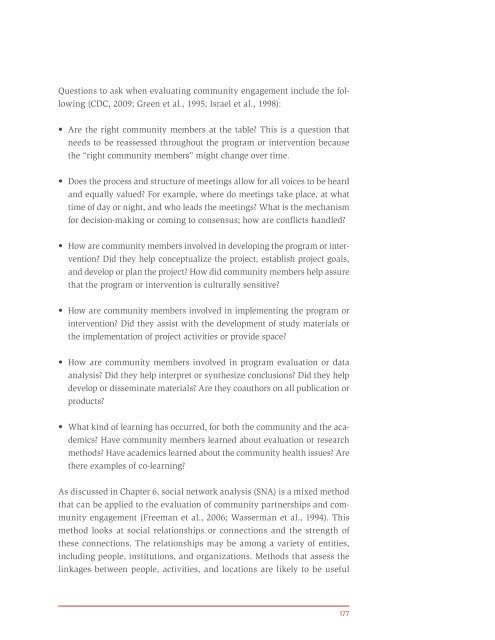Principles of Community Engagement (Second Edition)
Principles of Community Engagement (Second Edition)
Principles of Community Engagement (Second Edition)
You also want an ePaper? Increase the reach of your titles
YUMPU automatically turns print PDFs into web optimized ePapers that Google loves.
Questions to ask when evaluating community engagement include the fol-<br />
lowing (CDC, 2009; Green et al , 1995; Israel et al , 1998):<br />
• Are the right community members at the table? This is a question that<br />
needs to be reassessed throughout the program or intervention because<br />
the “right community members” might change over time<br />
• Does the process and structure <strong>of</strong> meetings allow for all voices to be heard<br />
and equally valued? For example, where do meetings take place, at what<br />
time <strong>of</strong> day or night, and who leads the meetings? What is the mechanism<br />
for decision-making or coming to consensus; how are conflicts handled?<br />
• How are community members involved in developing the program or intervention?<br />
Did they help conceptualize the project, establish project goals,<br />
and develop or plan the project? How did community members help assure<br />
that the program or intervention is culturally sensitive?<br />
• How are community members involved in implementing the program or<br />
intervention? Did they assist with the development <strong>of</strong> study materials or<br />
the implementation <strong>of</strong> project activities or provide space?<br />
• How are community members involved in program evaluation or data<br />
analysis? Did they help interpret or synthesize conclusions? Did they help<br />
develop or disseminate materials? Are they coauthors on all publication or<br />
products?<br />
• What kind <strong>of</strong> learning has occurred, for both the community and the academics?<br />
Have community members learned about evaluation or research<br />
methods? Have academics learned about the community health issues? Are<br />
there examples <strong>of</strong> co-learning?<br />
As discussed in Chapter 6, social network analysis (SNA) is a mixed method<br />
that can be applied to the evaluation <strong>of</strong> community partnerships and community<br />
engagement (Freeman et al , 2006; Wasserman et al , 1994) This<br />
method looks at social relationships or connections and the strength <strong>of</strong><br />
these connections The relationships may be among a variety <strong>of</strong> entities,<br />
including people, institutions, and organizations Methods that assess the<br />
linkages between people, activities, and locations are likely to be useful<br />
177

















